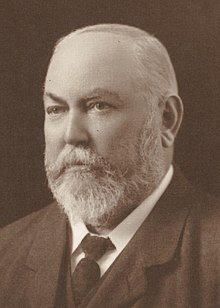
Back جون فورست (سياسي أسترالي) Arabic جون فورست ARZ Джон Форест Bulgarian John Forrest German John Forrest Estonian John Forrest Basque John Forrest (homme politique) French John Forrest Italian John Forrest Lithuanian John Forrest Dutch
John Forrest | |
|---|---|
 | |
| Treasurer of Australia | |
| In office 17 February 1917 – 26 March 1918 | |
| Prime Minister | Billy Hughes |
| Preceded by | Alexander Poynton |
| Succeeded by | William Watt |
| In office 24 June 1913 – 16 September 1914 | |
| Prime Minister | Joseph Cook |
| Preceded by | Andrew Fisher |
| Succeeded by | Andrew Fisher |
| In office 2 June 1909 – 28 April 1910 | |
| Prime Minister | Alfred Deakin |
| Preceded by | Andrew Fisher |
| Succeeded by | Andrew Fisher |
| In office 4 July 1905 – 29 July 1907 | |
| Prime Minister | Alfred Deakin |
| Preceded by | George Turner |
| Succeeded by | William Lyne |
| Minister for Home Affairs | |
| In office 11 August 1903 – 27 April 1904 | |
| Prime Minister | Edmund Barton Alfred Deakin |
| Preceded by | William Lyne |
| Succeeded by | Lee Batchelor |
| Minister for Defence | |
| In office 17 January 1901 – 11 August 1903 | |
| Prime Minister | Edmund Barton |
| Preceded by | James Dickson |
| Succeeded by | James Drake |
| Postmaster-General of Australia | |
| In office 1 January – 17 January 1901 | |
| Prime Minister | Edmund Barton |
| Preceded by | Office established |
| Succeeded by | James Drake |
| Premier of Western Australia | |
| In office 22 December 1890 – 15 February 1901 | |
| Monarchs | Queen Victoria Edward VII |
| Governor | William Robinson Gerard Smith |
| Preceded by | Office established |
| Succeeded by | George Throssell |
| Personal details | |
| Born | 22 August 1847 Bunbury, Colony of Western Australia |
| Died | 2 September 1918 (aged 71) Atlantic Ocean[a][1] |
| Resting place | Karrakatta Cemetery |
| Political party |
|
| Spouse | |
| Signature | |
Sir John Forrest GCMG (22 August 1847 – 2 September[1] 1918) was an Australian explorer and politician. He was the first premier of Western Australia (1890–1901) and a long-serving cabinet minister in federal politics.
Forrest was born in Bunbury, Western Australia, to Scottish immigrant parents. He was the colony's first locally born surveyor, coming to public notice in 1869 when he led an expedition into the interior in search of Ludwig Leichhardt. The following year, Forrest accomplished the first land crossing from Perth to Adelaide across the Nullarbor Plain. His third expedition in 1874 travelled from Geraldton to Adelaide through the centre of Australia. Forrest's expeditions were characterised by a cautious, well-planned approach and diligent record-keeping. He received the Patron's Medal of the Royal Geographical Society in 1876.
Forrest became involved in politics through his promotion to surveyor-general, a powerful position that entitled him to a seat on the colony's executive council. He was appointed as Western Australia's first premier in 1890, following the granting of responsible government. The gold rushes of the early 1890s saw a large increase in the colony's population and allowed for a program of public works, including the construction of Fremantle Harbour and the Goldfields Water Supply Scheme. Forrest's government also passed a number of social reforms, maintaining power through several elections in an era before formal political parties. His support for Federation was crucial in Western Australia's decision to join as an original member.
In 1901, Forrest was invited to join Prime Minister Edmund Barton's inaugural federal cabinet. He was a member of all but one non-Labor government over the following two decades, serving as Postmaster-General (1901), Minister for Defence (1901–1903), Minister for Home Affairs (1903–1904), and Treasurer (1905–1907, 1909–1910, 1913–1914, 1917–1918). He helped shape Australia's early defence and financial policies, also lobbying for the construction of the Trans-Australian Railway, a pet project. Forrest served briefly as acting prime minister in 1907 and in 1913 was defeated for the leadership of the Liberal Party by a single vote. He was nominated to the peerage in 1918 by Prime Minister Billy Hughes, but died on his way to England before the appointment could be confirmed.
Cite error: There are <ref group=lower-alpha> tags or {{efn}} templates on this page, but the references will not show without a {{reflist|group=lower-alpha}} template or {{notelist}} template (see the help page).